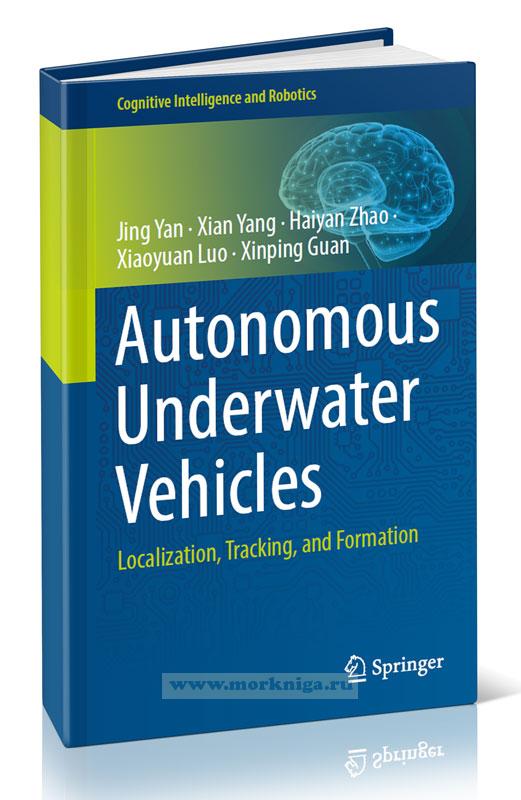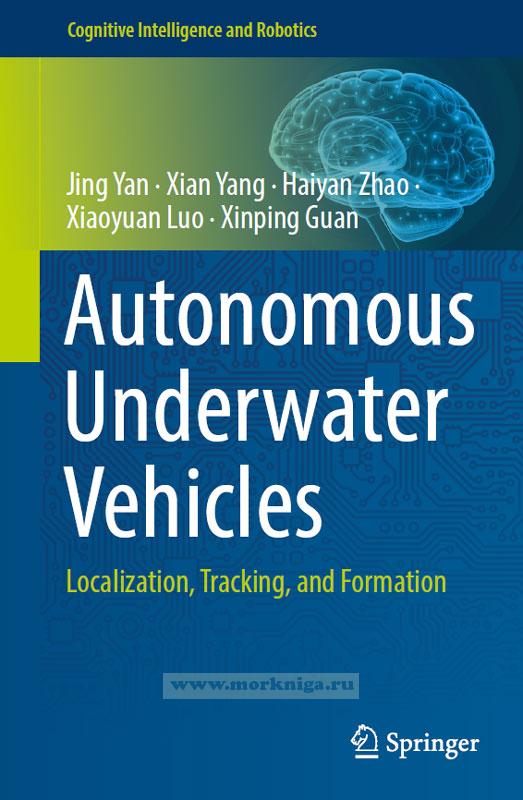Autonomous Underwater Vehicles. Localization, Tracking, and Formation/Автономные подводные аппараты. Локализация, отслеживание и создание
Издание на английском языке
Ocean covers 70.8% of the earth’s surface, and it plays an important role in supporting system of life on the earth.Nonetheless, more than 80% of the oceans volume remains unmapped, unobserved, and unexplored.With regard to this, autonomous underwater vehicles (AUVs) are emerged as a promising solution to understand and explore the ocean, due to their autonomy and mobility. AUVs have a variety of military and civilian applications, such as the intrusion surveillance, geographic mapping, marine rescue, and petroleum exploration. It is worth noting that the global market for AUVs is estimated to growfrom 638 million dollars in 2020 to 1638 million dollars by 2025, at a compound annual growth rate of 20.8%. To enable AUVs for a wider range of application-specific missions, it is necessary to deploy multiple AUVs to cooperatively perform the localization, tracking, and formation tasks. However, the weak communication of underwater acoustic communication and the model uncertainty of AUVs make it challenging to achieve the localization, tracking, and formation tasks.
Contents
1 Introduction
1.1 Underwater Observation Network
1.2 An Overview of the Existing Works
1.2.1 Ubiquitous Localization of AUVs
1.2.2 Persistent Tracking Control for a Single AUV
1.2.3 Cooperative Formation for Multiple AUVs
1.3 Research Challenges and Contributions of This Book
References
2 Rigid Graph-Based Asynchronous Localization of AUVs
2.1 Introduction
2.2 Network Model and Problem Formulation
2.2.1 Network Model
2.2.2 Problem Formulation
2.3 Main Results
2.3.1 Observer-Based Motion Prediction for AUV
2.3.2 Minimum Rigid Graph-Based Localization
2.3.3 Performance Analyses
2.4 Simulation and Experimental Results
2.4.1 Simulation Studies
2.4.2 Experiment Studies
2.5 Conclusion
References
3 Slide Mode-Based Joint Localization and Tracking of a Single AUV
3.1 Introduction
3.2 System Model and Problem Formulation
3.2.1 Model Constructions
3.2.2 Problem Formulation
3.3 Joint Localization and Tracking Design
3.3.1 Self-localization Algorithm Design
3.3.2 Model-Free Tracking Controller Design
3.4 Performance Analysis
3.4.1 Convergence of the Localization Algorithm
3.4.2 CRLB of the Localization Algorithm
3.4.3 Boundness of the TDE Error
3.4.4 Convergence for the Tracking Controller
3.5 Simulation and Experimental Results
3.5.1 Simulation Studies
3.5.2 Experimental Studies
3.6 Conclusion
References
4 Joint Localization and Tracking of AUV Via Multivariate Probabilistic Collocation
4.1 Introduction
4.2 System Model and Problem Formulation
4.2.1 Model Constructions
4.2.2 Problem Formulation
4.3 Joint Localization and Tracking Design
4.3.1 Self-localization Algorithm Design
4.3.2 RL-Based Tracking Controller Design
4.4 Simulation Studies
4.5 Conclusion
References
5 Finite-Time Tracking Control of AUV with Model Uncertainty
5.1 Introduction
5.2 System Formulation
5.3 Control Design and Stability Analysis
5.3.1 Tracking Control Without Disturbance
5.3.2 Finite-Time Tracking Control with Disturbances
5.4 Simulation
5.5 Conclusion
References
6 Finite-Time Tracking Control of AUV Without Velocity Measurements
6.1 Introduction
6.2 Problem Formulation
6.3 Finite-Time Tracking Approach
6.3.1 Finite-Time Velocity Observer
6.3.2 A-NFTSM Tracking Controller
6.4 Performance Analyses
6.4.1 Accuracy of the Buoy-Assisted Localization
6.4.2 Stability Analysis for the Velocity Observer
6.4.3 Stability Analysis for the Tracking Controller
6.5 Simulation and Experimental Studies
6.5.1 Simulation Studies
6.5.2 Experimental Studies
6.6 Conclusion
References
7 Tracking Control of AUV with Time Delay and Input Saturation
7.1 Introduction
7.2 Model and Problem Formulation
7.3 Controller Design and Stability Analysis
7.3.1 Design of the Tracking Controller
7.3.2 Stability Condition and DOA Estimation
7.4 Simulation and Experiment Results
7.4.1 Simulation Studies
7.4.2 Implementation and Experimental Studies
7.5 Conclusion
References
8 Tracking and Formation for Multiple AUVs with Time Delay
8.1 Introduction
8.2 Problem Formulation
8.3 Controller Design and Stability Analysis
8.3.1 Tracking Control for Single-AUV System
8.3.2 Formation Control for Multi-AUV System
8.4 Simulation and Experimental Results
8.4.1 Simulation Studies
8.4.2 Experimental Studies
8.5 Conclusion
References
9 Future Research Directions
9.1 Space-Air-Ground-Sea Network Architecture
9.2 Channel Prediction for Communication Support
9.3 Model-Free Optimization Control
References

